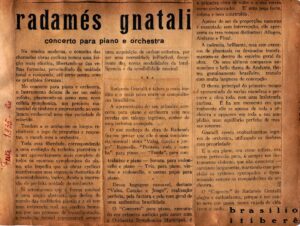- On June 21, Radamés presents hisConcerto [nº 1], para piano e orquestra (1934)in the first world audition, at Theatro Municipal do Rio de Janeiro, with the Municipal Orchestra, conducted by conductor Henrique Spedini.

Festa – Revista de arte e pensamento – 2nd phase – anno I – August 1935 – nº 9 (RJ) ‘Radamés Gnattali – concerto for piano and orchestra’, by Brasílio Itiberê
- The Victor label releases Radamés’ choros Saudoso, Tristonho, choro-batuque
Dengoso
the polka-choro
Village Style [1]
, the waltzes Berenice e
Entardecer
and the arrangement of moda riograndense
Prenda minha
interpreted by Almirante and Paulo Tapajós.
Radamés composes:
-
Alma Brasileira (choro), for piano and string orchestra
(from the original for piano)
Gaita, for piano and song
(third song from the series Three poems by Augusto Meyer, begun in 1931)
Sonata No. 1 for cello and piano
– dedicated to Iberê Gomes Grosso
- On March 28th, in Rio de Janeiro (RJ), poet, writer, composer, and producer Hermínio Bello de Carvalho was born. He was responsible for historic Brazilian artistic productions, including shows, concerts, musical performances, and phonographic recordings. As director of FUNARTE’s Popular Music Division in the 1970s and 80s, Hermínio created an important research center for Brazilian popular music, with institutional support for artistic-cultural projects that resulted in the publication of books, records, scores and staging of shows.
- Dies, in São Paulo (SP), Zequinha de Abreu (José Gomes de Abreu), composer of the famous choro Tico-tico no fubá.
- The maestro and composer Chiquinha Gonzaga (Francisca Edwiges Neves Gonzaga), whom Radamés reveres in the 4th movement of Portraits,for mandolin soloist, choro ensemble and string orchestra (1956).
- Military rebellions break out in battalions in Rio Grande do Norte, Pernambuco, and Rio de Janeiro. The movement is known as the Intentona Comunista.
- Two more radios are inaugurated in Rio de Janeiro: Tupi and Ipanema.

